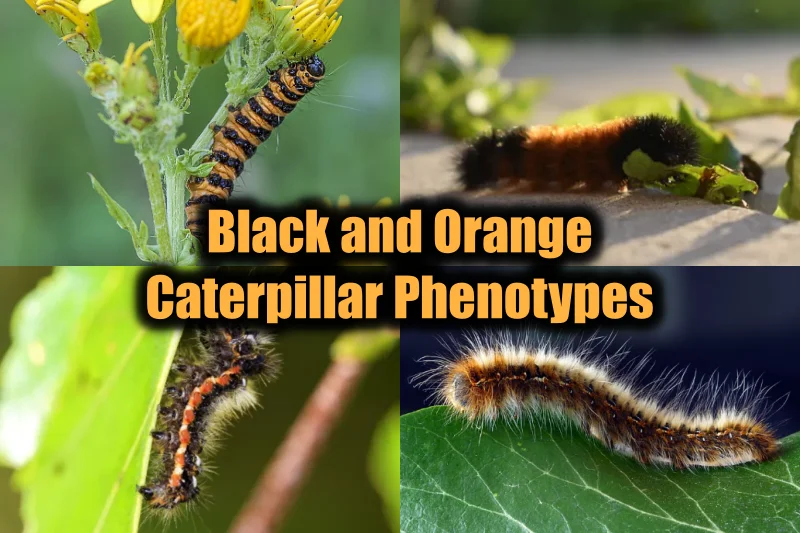The beautiful butterflies and moths you see with their glittery wings flapping don’t just come into the world as they are. They go through many rigorous stages of change to become what they are today.
One of these stages includes the caterpillar. Unlike their many counterparts, these magnificent creatures stand out in terms of their appearance. They boast a variety of colors; if you can think of a color, you’ll likely find a caterpillar in that shade. These majestic creatures can be hairy, spiky, or adorned with tufts.
Today, we bring to you yet another comprehensive list of 40 caterpillars with orange and black coloration. Nature has given its inhabitants a means to survive, and these beautifully colored caterpillars are designed for their safety.
This coloration serves dual functions, acting both as a warning signal to potential predators about potential unpalatability or toxicity and as a form of camouflage or mimicry.
The contrasting colors play a crucial role in the caterpillar’s survival strategy, allowing it to blend into its environment while simultaneously communicating its defenses to potential threats.
40 Black and Orange Caterpillar Phenotypes in The Wild
1) Redhumped Moth Caterpillar
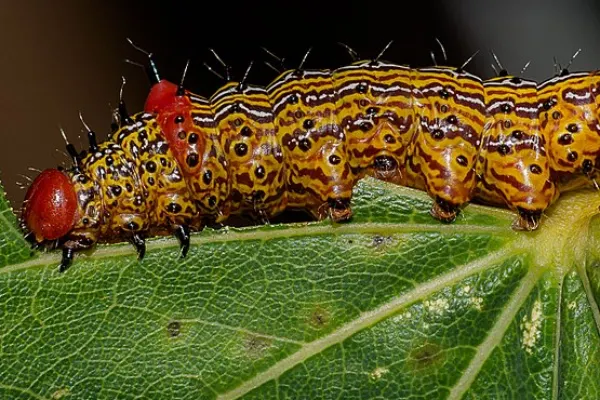
Scientific Name: Schizura concinna
While the eggs of this species start as yellow, the Redhumped Moth Caterpillar soon transitions into orange on hatching.
The orange hue gradually darkens and transforms into a stunning red and brown combination.
They can grow up to 1.5 inches. Their bodies are primarily orange and yellow with black and white stripes and a majestic orangey-red rounded head and hump on their back.
Their coloration warns the predators of their unpalatable nature and toxicity.
2) Orange Cinnabar Moth Caterpillar
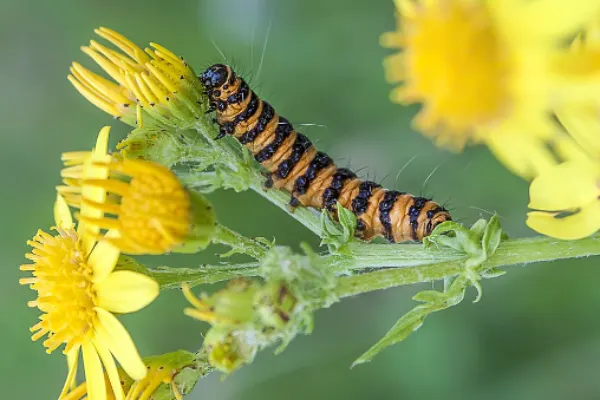
Scientific Name: Tyria jacobaeae
The captivating black and orange striped pattern on their bodies makes them easily identifiable.
The cinnabar caterpillar features long feathery spines on its body, adding to its unique appearance.
They also have three pairs of black legs at the front and four pairs of black and orange prolegs in the middle section of their bodies.
The cinnabar caterpillar’s coloration serves as a warning sign to potential predators that it is poisonous
They are known to exhibit cannibalistic tendencies, especially when food sources are scarce.
3) Yellow-tail Moth Caterpillar
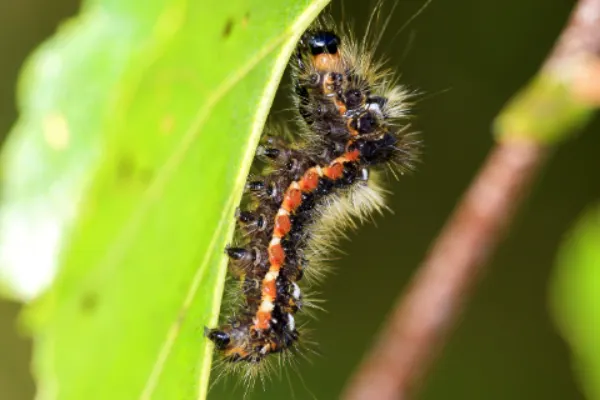
Scientific Name: Sphrageidus similis
They have black spiny bodies adorned with vibrant orange bands running down their backs.
Yellow-tail moth caterpillar are covered in fine, dense hairs, and their body is distinctly hairy and textured.
Along the sides of its body, the caterpillar showcases distinct white spots or patches.
They can grow up to a length of 1.69-2 inches.
They primarily feed on the leaves of various tree species such as birch, fruit trees, hawthorn, oak, and rowan.
4) Spiny Oakworm Caterpillar
Scientific Name: Anisota stigma
They have a pale orange base color with contrasting black spines, black dots, and filaments on their bodies.
They have numerous black spines on their bodies, contributing to their distinct appearance with white dots distributed across.
They use oak trees as their primary host. However, they are also known to occasionally inhabit other trees such as hazel.
They pupate underground during the winter.
The coloration of their bodies remains consistent throughout their life stages.
5) Isabella Tiger Moth Caterpillar
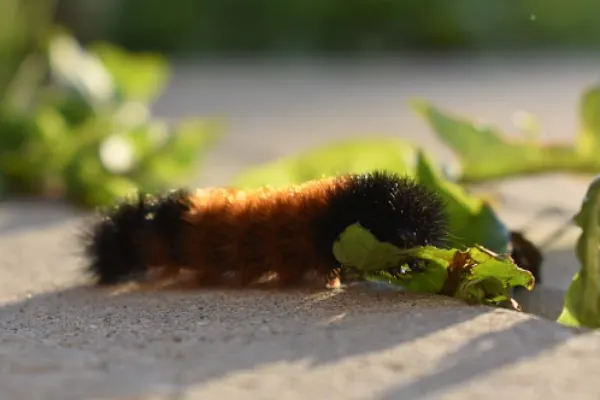
Scientific Name: Pyrrharctia isabella
They have long hairs on their bodies that are partly orange and partly black, creating a distinctive and eye-catching appearance.
Their hairy body is divided into 13 segments, with the midsegments covered in brownish-red hair. These brownish-red hair appear orange under sunlight.
Although visually appealing, the long hair on these animals can irritate the skin of humans if they come into contact with it.
Several distinct color morphs can be seen in particular individuals of this species.
They can adapt to a wide range of habitats and feed on a wide variety of plants and trees.
6) Passion Butterfly Caterpillar
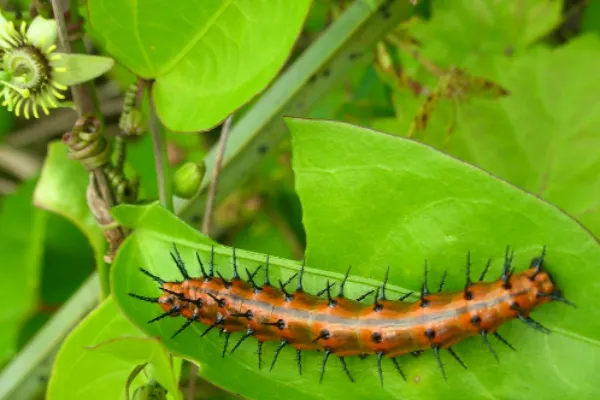
Scientific Name: Dione vanillae
They have dark orange bodies with grayish-black stripes, adorned with black spikes with tiny hairs.
The fact that these caterpillars feed almost exclusively on the foliage of plants in the family Passifloraceae is what gives them the common name “passion butterfly caterpillar.”
One thing that sets them apart is the way they eat their leaves, they only eat the inner portions of leaves, feeding away from the leaf margins.
As they age, they take on a hue that is somewhere between a burnt and rusty orange.
The caterpillar stage lasts for about 11-16 days, the specific duration might differ with the environmental conditions.
7) Fox Moth Caterpillar
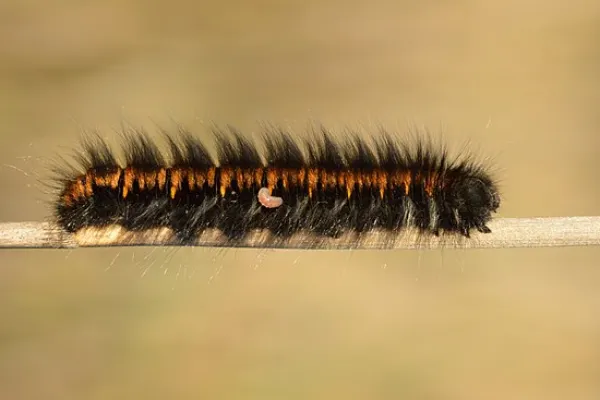
Scientific Name: Macrothylacia rubi
They have a body that is covered in black hair and has segments of bright orange along its back.
They can grow up to 7 cm in length.
Feeds on a wide variety of plants, including trees, flowering shrubs, and perennials, as well as birch trees, willows, and plants in the bean family.
Found in large numbers in the prairies, moors, and open woodlands of Western Europe, Central Asia, and Siberia respectively.
They spend their winters tucked under logs or leaves until the spring.
The wings of males have a bluish-gray hue to them, whereas the wings of females are typically much paler in color.
8) Oleander Caterpillar
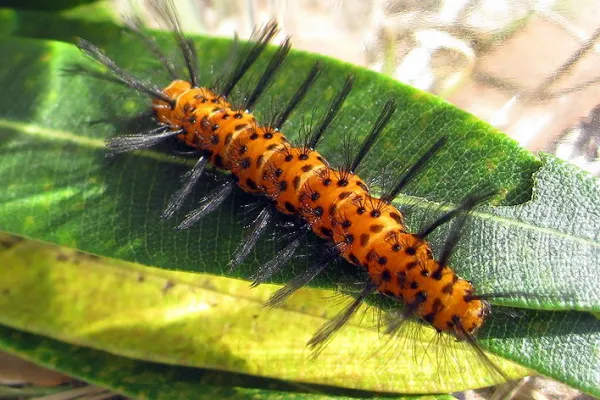
Scientific Name: Syntomeida epilais
They have vibrant orange bodies with contrasting black bumps and tufts of long black hair.
The majority of predators will avoid eating them because of their unpleasant flavor, which also serves as a visual warning to potential attackers.
As far as their toxicity goes, they haven’t proven to be dangerous to humans.
They mainly feed on oleander plants for their nourishment during the larval stage before pupation.
They can sometimes be seen feeding on devil’s potato plants and desert rose plants.
As they develop into caterpillars, they undergo a metamorphosis that results in the stunning appearance of a blue moth with iridescent coloring and polka-dot wings.
9) Rusty Tussock Caterpillar
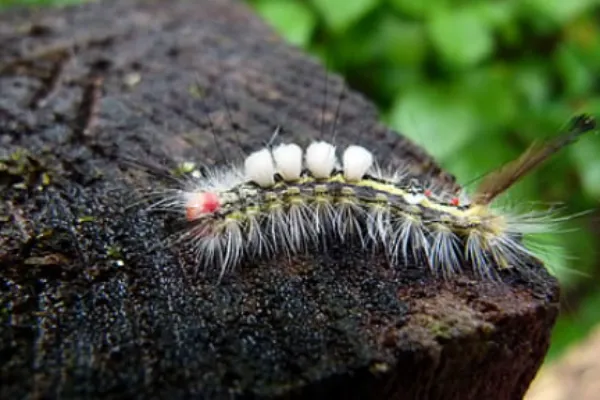
Scientific Name: Orgyia antiqua
Their black bodies are covered in tubercles that are vibrant orangey-red color and have tufts of orange and yellow hair that resemble horns.
They are easily distinguished from one another thanks to the fact that their backs have four tufts that are yellowish and shaped like toothbrushes.
The caterpillar has four white glands on its dorsum that contain toxins; to release these toxins, the caterpillar rubs its bristle-like hairs against the glands.
Humans are known to be irritated by these toxic substances.
They typically make their debut in the warmer months of summer and can be found in certain areas up until the beginning of October.
10) Drinker Moth Caterpillar
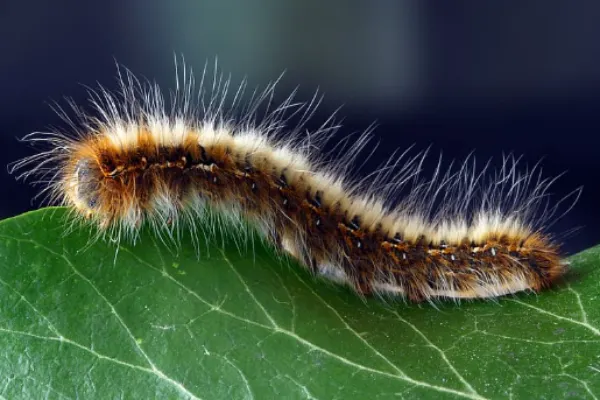
Scientific Name: Euthrix potatoria
Drinker Moth Caterpillar is orange-brown, and it is covered in tufts of hair that are orange, white, and black.
The presence of black and orange bands that run the length of its back is one of the defining characteristics of a drinker moth. These bands run in a lengthwise direction.
These bands are accompanied by lines of orange dots, adding to their colorful and eye-catching appearance.
On their middle segments, they have four pairs of orange prolegs that are covered in hair.
The caterpillar uses its prolegs, which are not true legs but rather specialized abdominal appendages, to move around and cling to surfaces.
11) Cape Lappet Moth Caterpillar
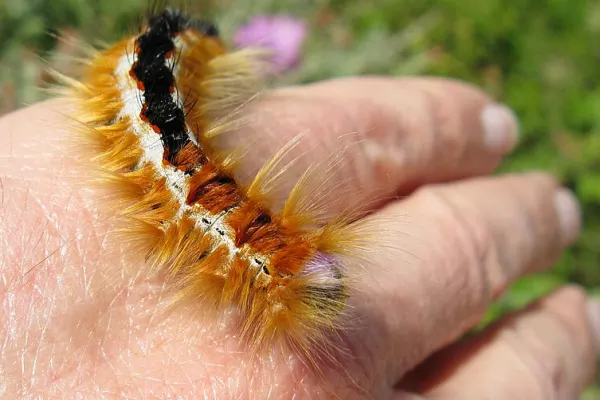
Scientific Name: Eutricha capensis
These caterpillars have dense clumps of brightly colored orange hairs along their sides, giving them a very distinctive appearance.
The caterpillar has a distinctively hairy and textured appearance thanks to these tufts of hair.
The white back of these animals has a distinct and easily recognizable pattern created by a thin black band that runs the length of the back.
They are relatively large, measuring up to 2.4 inches in length.
They can be found primarily in South Africa, where they feed on a wide variety of African plants.
12) Mourning Cloak Caterpillar
Scientific Name: Nymphalis antiopa
They have a spiky and textured body that is black, and their spines are short and black.
They are easy to recognize because their bodies are black and have eight orangey-red dots, with one dot located on each segment.
Their spiky textured body measures around 2 inches.
They can be found in a wide variety of environments, including hardwood forests as well as other settings.
The striking color differences act as aposematic signals, alerting potential predators to the potential toxicity of the caterpillar’s diet.
13) Spurge Hawk-moth Caterpillar
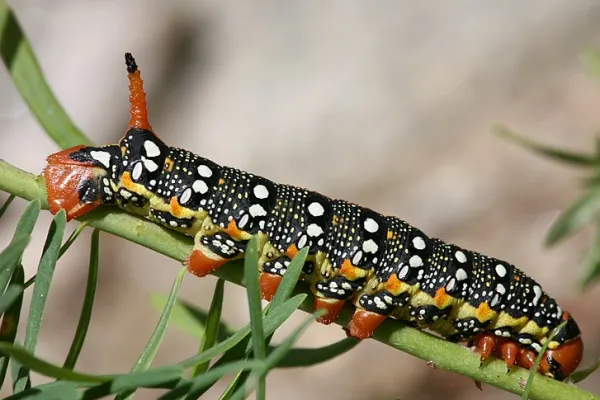
Scientific Name: Hyles euphorbiae
They have a smooth black body with prominent orange markings.
Their entire body, including their head, legs, and prolegs, is bright orange, which stands out dramatically against the dark background.
The caterpillar’s tail has a distinct orange horn with a black tip, which is one of the characteristics that sets it apart from other species.
Because they are found feeding on the leafy spurge plant, they are utilized as a biological pest control agent against the spurge plant.
14) Milkweed Tiger Moth Caterpillar

Scientific Name: Euchaetes egle
Their black body is adorned with bright orange tufts of hair, giving them a very eye-catching appearance.
The presence of grayish or whitish tufts gives them yet another unique characteristic.
They frequently feed on the dogbane and milkweed plants where they are found.
They are born with a mottled appearance that consists of shades of black, orange, and a color that is somewhere between blue and gray, but as they age, their overall appearance becomes darker.
This coloration is more than just for aesthetics, they are the crucial aspect of their survival.
It serves as a form of defense, discouraging predators from consuming the caterpillar.
15) Powdered Dagger Caterpillar
Scientific Name: Acronicta impleta
Young Dagger caterpillars are primarily orange in color, and their bodies feature only a few minute black spots here and there.
When fully grown, they have a predominantly black coloration and bright orange sections densely cover their bodies.
The presence of a bright globe-like head makes them stand out.
In addition to the tufts that are black and orange, they also have a beautiful blend of tufts that are gray and white.
Their contrasting color serves dual purposes, acting both as potential unpalatability or toxicity and as a form of camouflage or mimicry.
16) Long-Winged Dagger Caterpillar
Scientific Name: Acronicta longa
Their dorsal side displays a pattern of orange areas separated by bold black bands.
Long-winged dagger also possesses hollow hair connected to toxin glands, allowing toxins to flow from the glands to the tips of the hair.
Direct contact with the toxins, can cause rashes and redness that persist for up to a week.
Applying strong adhesive tape on being exposed can remove the fine hair from clothes or the body.
They reside in places with alder, birch, poplar, hawthorn, and willow trees, which serve as their primary food sources during their larval stage.
17) Pipevine Swallowtail Caterpillar

Scientific Name: Battus philenor
They have small projections called tubercles. The color of these tubercles changes according to the area.
Caterpillars in populations across the Eastern United States sport vibrant orange tubercles. However, those found in the Southern states showcase a different color palette with striking red tubercles.
They feed on knotweed and wild ginger, impacting their populations.
18) Malachite Caterpillar
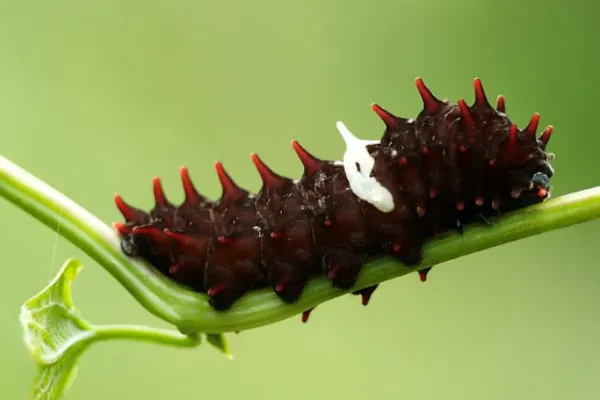
Scientific Name: Siproeta stelenes
Their beautifully striking black body is adorned with multiple orange dots across its dorsum.
The combination of black and orange creates a visually distinctive appearance that serves various ecological functions, including camouflage, mimicry, or warning signals.
Native to the United States and are widely distributed throughout Central and northern South America.
They display variations in coloration depending on the region and its local environmental conditions, such as temperature, sunlight, and available food sources.
Ruellia plants are among the most common hosts for this species.
19) Silvery Checkerspot Caterpillar
Scientific Name: Chlosyne nycteis
Silvery Checkerspot Caterpillar is predominantly black, with dusted white spots along with yellow-orange stripes or smaller stripes.
They have a big appetite feeding on Eurybia macrophylla, Verbesina alternifolia, as well as Helianthus and Rudbeckia.
They prefer moist environments such as stream sides, meadows, and forest openings, where the host plants are found.
20) Old World Swallowtail Caterpillar
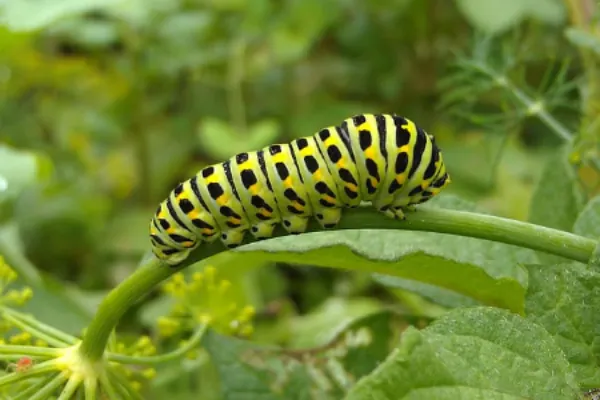
Scientific Name: Papilio machaon
These caterpillars possess a plump body with a bright green base providing a stark contrast to the bold black and orange bands.
They measure 1.8 inches (4.5 cm) in length and when combined with their plump body give them an edge against their predators.
Their plump and colorful appearance is not only visually striking but also aids in the caterpillar’s defense mechanisms against predators.
21) Regal Moth Caterpillar
Scientific Name: Citheronia regalis
Their bluish-green body is adorned with short black spikes, black-tipped orange horns, and an orange tail end.
The most distinctive feature is the presence of several arched, spiky, and black-tipped red horns near its head.
The regal moth holds the title of being the largest caterpillar in the world by reaching an astonishing length of approximately 6 inches (15 cm).
Despite its intimidating size and appearance, this caterpillar is harmless and generally timid.
Unlike some other moth species, they do not spin cocoons. This unique pupation behavior helps protect them during their transformation into moths.
22) Tetrio Sphinx Caterpillar
Scientific Name: Pseudosphinx tetrio
They have jet-black bodies with bright orange legs, heads, and tails along with distinctive yellow bands separating the segments.
Tetrio has a coat of hair often referred to as “urticating hairs,” which can cause significant irritation if touched.
They feed on plants such as Plumeria species, including red frangipani and white frangipani, all of them belonging to the family- Apocynaceae.
Despite the toxic latex present in most Apocynaceae plants, these caterpillars have adapted to detoxify these substances and safely consume them.
23) Variegated Fritillary Caterpillar
Scientific Name: Euptoieta claudia
They begin their life as white and orange caterpillars.
However, as they mature, they gradually transition into a striking pattern of alternating black, white, and orange stripes.
They have black bristle-like hairs across their bodies serving as a form of self-defense.
Found in open, disturbed environments such as clover and alfalfa fields, pastures, waste areas, roadsides, and mountain meadows.
They also show migratory behavior, allowing them to move to suitable habitats for their life stages.
24) Mexican Fritillary Caterpillar
Scientific Name: Euptoieta hegesia
These caterpillars have dark orange as their predominant color, with black and white markings running down their back.
Typically found in remote areas of Texas and Arizona, as well as in parts of Mexico.
They primarily feed on passionflower and various violets which play a crucial role in their life cycle and contribute to their unique appearance.
25) Garden Tiger Caterpillar
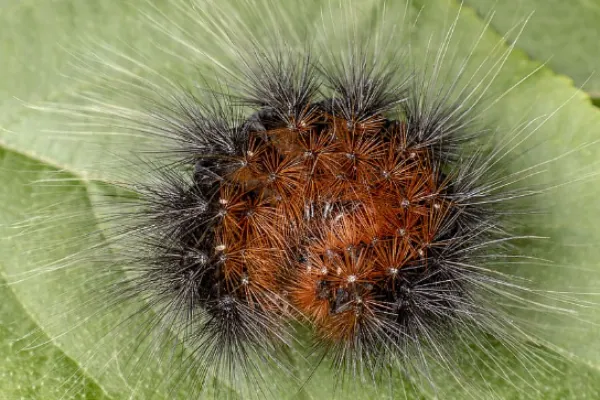
Scientific Name: Arctia caja
They have long, dense black hairs covering the dorsal side of their bodies creating a stark contrast against their primary background color, orange.
One thing that sets them apart, is their ability to consume plants high in toxins, such as pyrrolizidine alkaloids.
By feeding on these toxic plants, they absorb toxins, which makes them a not-so-great choice to feast on.
Native to North America and Europe, primarily inhabiting cold, temperate climates.
26) Faithful Beauty Caterpillar
Scientific Name: Composia fidelissima
Faithful Beauty Caterpillar is a combination of orange and black, mostly orange when they are young. However, as they mature, the black starts to be prominent.
Black sections of their bodies are characterized by longer hairs, creating a textured appearance.
Primarily feeds on specific plant species, including Oleander (Nerium oleander) and jack beans (Canavalia species), contributing to their coloration.
As they may absorb certain compounds or pigments from their diet that influence their appearance.
27) Asimina webworm moth
Scientific Name: Omphalocera munroei
They have a black body with wide orange bands running down their dorsal side.
They also have tiny white spots spread between black and orange segments.
These spots likely serve various purposes, including camouflage, communication, or deterring potential predators.
Primarily found in the United States, including states like Florida, Indiana, and West Virginia.
They are very specific with their diet, feeding mostly on Asimina species, particularly the pawpaw tree. Hence, they are sometimes also referred to as Pawpaw Webworms.
Due to their feeding habits, they have the potential to cause considerable damage to pawpaw trees.
28) Clemens’ false skeletonizer
Scientific Name: Acoloithus falsarius
Initially orange, but as they mature, black sections gradually appear on their bodies.
They have a narrow black band running along their dorsum side, which serves as a striking contrast to its predominantly orange body.
On maturation they also develop wider black bands on the sides of their bodies, creating an even more beautiful pattern.
Found in North America, including multiple and throughout Mexico.
29) Pacific Tent Caterpillar
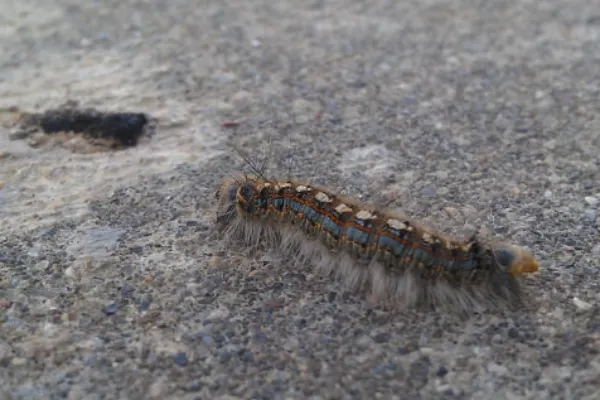
Scientific Name: Malacosoma constricta
On the black sections of their bodies, Pacific Tent caterpillars have multiple tiny white dots and pale-yellow tufts on the side.
They are known to exhibit different color morphs, with one common morph featuring black and orange coloration and another with black and red patterns.
While California Wild Rose remains one of the most common host flowers for this species, they are commonly found feeding on host trees such as Coast Live Oak and Blue Oak.
They are usually found in groups and during an outburst, they have the potential to destroy the host plant.
30) Arizona Caterpillar
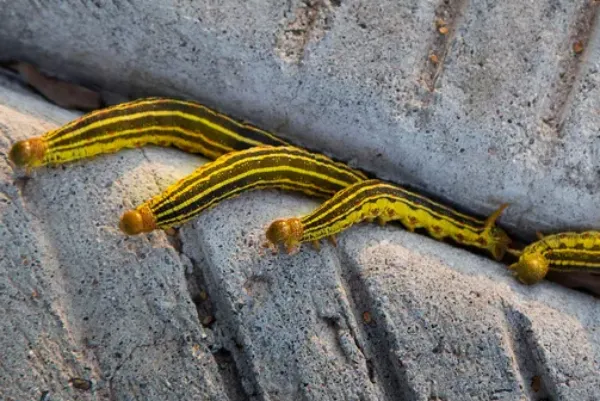
Scientific Name: Apantesis incorrupta
They display a combination of orange and black sections on their bodies, with a black dorsal side and reddish-orange hair.
Found in various regions, ranging from southern Colorado and southeastern Kansas to parts of Arizona, New Mexico, western Texas, and even southeastern California.
They commonly feed on the Apache plume, a wild herbaceous plant. This plant is typically found in grasslands and along the edges of woodlands.
Yet another fascinating fact about these caterpillars is that they intentionally consume alkaloid-laden leaves that contain compounds to fight off internal parasitic fly larvae.
31) Ranchman’s Tiger Moth Caterpillar
Scientific Name: Arctia virginalis
Ranchman’s Tiger Moth Caterpillars are black caterpillars with an orange head and tail, and as they mature, they develop multiple bright orange spots across their bodies, giving them an aesthetic appearance.
Native to western North America and primarily found in regions ranging from southern Monterey Bay in California to southern British Columbia in Canada.
They can survive in a variety of habitats, including wet lowland prairies, wet meadows, wet forests, and riparian zones along creeks in arid desert areas.
They feed on herbaceous plants, hence controlling their population.
32) Wood Tiger Caterpillar
Scientific Name: Arctia plantaginis
Wood Tiger Caterpillars have distinctive coloration, which includes orange and black, as well as white in some cases.
They are commonly found in riparian areas or zones near water sources across North and Central America.
Depending on the plant they feed on, they can produce defensive toxins.
This process has proven to be energy-intensive for the caterpillars.
Arctia plantaginis are known for their polyphagous nature, meaning they have a varied diet.
They feed on various herbaceous plants, extracting essential nutrients that are crucial for their development, this allows Wood Tiger moths to remain unfed for a long time.
Like many other caterpillars, they extract toxins from their host plants that make them taste bad for potential predators.
33) West Indian Mangrove Buckeye Caterpillar
Scientific Name: Junonia genoveva
They have a black dorsum with long dark hair, while their sides are bright orange.
When these caterpillars metamorphose into adults, some of the colors they display as caterpillars are retained in their butterfly form.
They are mostly found in southern Florida, Texas, and various locations in the Caribbean.
While they are mostly brown, they show black and orange coloration for defensive purposes.
Wild petunias are one of their most common host plants.
34) Cactus Moth Caterpillar
Scientific Name: Cactoblastis cactorum
These caterpillars are characterized by their vivid orange and black coloring.
The body is mainly orange, with distinct black bands or spots running from one end to another, creating a striking appearance.
In some regions particularly in Australia, they are preferred as they feed on invasive cacti species, such as the prickly pear cactus.
In South America, Cactoblastis cactorum plays a major role in the food chain, serving as a food source for various New World monkeys.
35) Orange-Tipped Oakworm
Scientific Name: Anisota senatoria
They have dark green or black stripes with alternating orange stripes in their early stages, and small black spikes on their backs.
However, this black and orange striping is pronounced only in their earlier stages.
In the final stage, the caterpillar primarily exhibits black and white colors across its body.
They feed on the leaves of oak trees, specifically Quercus species, with a preference for red oaks, largely affecting their appearance.
These species grow tremendously in number during August and September, potentially damaging the oak trees.
36) Unexpected Cycnia Moth Caterpillar

Scientific Name: Cycnia inopinatus
Throughout their life, they maintain an orange body with black tufts and black hair scattered across its body. They primarily feed on the leaves of these milkweed plants.
Like many other species, here the caterpillar exhibits bold orange and black colors, while the adult moths of the species have a completely different appearance.
The adults are predominantly white or cream-white.
They are native to the United States, particularly in the eastern part of the country, and can be found in Mexico too.
37) Buck Moth Caterpillar
Scientific Name: Hemileuca maia
During their later stages, they exhibit a combination of orange, black, and gray color all over their bodies.
Adult Buck Moths have a gray-to-black upper body and a vivid orange lower body, creating a striking contrast.
They have a unique set of spiny hair-like structures that act as their defense mechanism.
They can be found across a wide geographic range in the United States, stretching from peninsular Florida to New England and extending as far west as Texas and Kansas.
Buck Moths feed on various oak species, including scrub oak, live oak, blackjack oak, white oak, and dwarf chinquapin oak.
38) Yellow-Winged Pareuchaetes Caterpillar
Scientific Name: Pareuchaetes insulata
They have orange and black patterns on their bodies helping them escape their predators.
Primarily found in tropical and subtropical regions and known to inhabit Florida and Southern Texas within the United States.
They feed on various plant species the common ones being Chromolaena odorata, Ageratum species, and Hernandia sonora.
On reaching the moth stage, they feature a white upper body with a pale orange lower body.
39) Baltimore Checkerspot Caterpillar
Scientific Name: Euphydryas phaeton
Young caterpillars are generally white with orange and black dots distributed across their bodies.
As they mature, their bodies majorly become black with prominent orange and white dots and marks.
They are native to Eastern North America and are known to inhabit a wide range of habitats, including both wet and dry areas.
Instead of overwintering as eggs, pupae, or adult butterflies, they overwinter as larvae.
In late summer, typically between July and September, these caterpillars spin a pre-hibernation web on a plant, cease feeding, and remain within the web.
This behavior is a strategic means to survive extreme climatic conditions in their surroundings.
40) Sonoran Tent Caterpillar
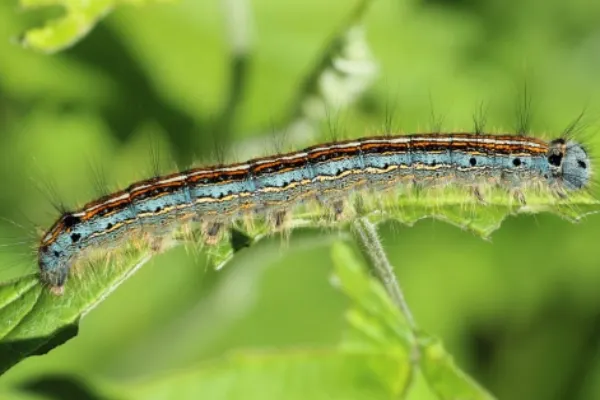
Scientific Name: Malacosoma tigris
Their bright orange body lacks hair and features multiple black bands.
As they start to mature, the orange hue slowly starts to diminish while the black begins to darken.
During their growing stage, the presence of hair, which can be white or yellow, starts to be prominent.
While they are not considered invasive, during their pupation stage they form silky colonies, which are quite noticeable.
Conclusion:
Now that we’ve come to an end, we hope you’ve learned more about these beauties as we did while researching and reading about them. Furthermore, this coloration is a powerful example of how evolution has shaped these caterpillars to thrive in their environment by using color as a means of their defense.
This comprehensive list of the top 40 orange and black caterpillars is one of the many creations of nature. This list contains caterpillars with varied habits and characteristics that make them different from the others.
While one has white dots all over its black and orange body, the other has spiny hair with toxins. While pupates during winters, the others during summer. Their eating habits vary widely too, rather than just sticking to their natural diet, some of these are known to resort to cannibalism during scarcity of food.
So next time you see an orange and black caterpillar, think about the varied possibilities and ways these creatures have evolved to survive amongst the rest of us.
Also Read:

Hi everyone, my name is Shawna, and I’ve always been fascinated by the fascinating diversity of flora and fauna that our nature has in it. I am currently studying biotechnology and am particularly interested in animal biotechnology, delving into the intricate processes that define their true nature and uniqueness.
